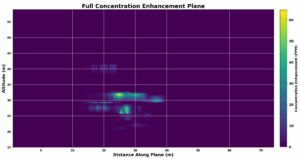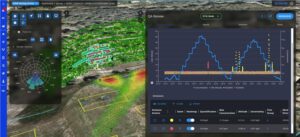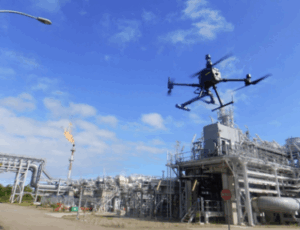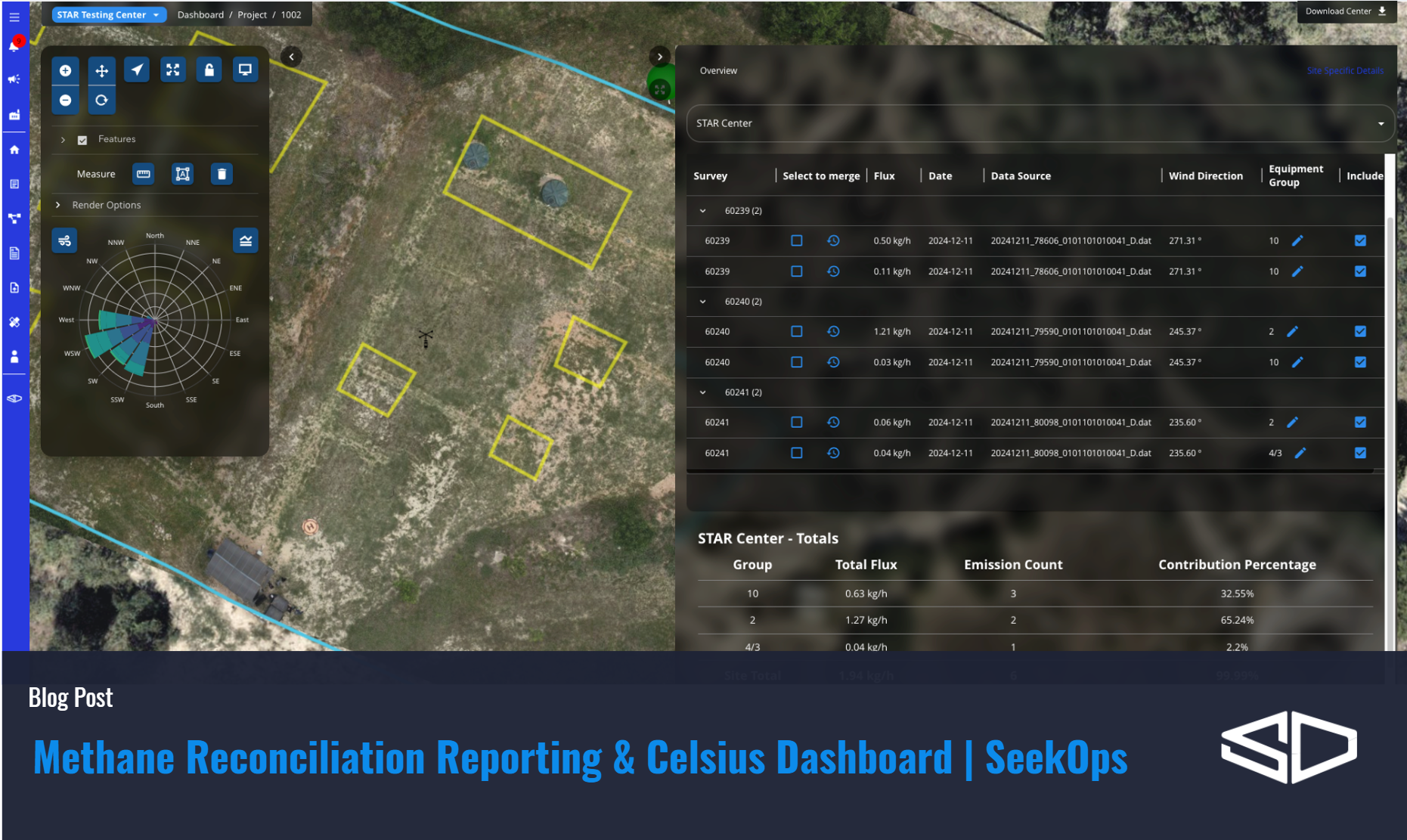Learn how SeekOps helps operators compare measured and reported methane emissions using reconciliation reporting and the Celsius analytics platform.
Read time: 5 minutes
Beyond Measurement: Why Reconciliation Matters
Accurately detecting and quantifying methane emissions is just the first step. But raw data, no matter how precise, doesn’t solve the bigger question: what does this mean for the operator?
That’s where reconciliation comes in. At SeekOps, we don’t just hand over measurement numbers, we can help operators interpret them in the context of what’s already known. Reconciliation aligns top-down measured data with bottom-up reported values from emissions inventories, equipment logs, and operational activity.
This “closing of the loop” delivers practical insights. It helps operators meet regulatory and voluntary reporting standards like OGMP 2.0, EPA requirements, and the EU Methane Regulation for one. Additionally, it can improve the accuracy of corporate emissions inventories, identify sources that may be under- or over-reported in bottom-up data, and feed continuous improvement cycles for emissions reduction strategies.
In short, reconciliation turns numbers into context, and context into action.
What Is Reconciliation Reporting?
Reconciliation reporting is the process of comparing what is measured during a SeekOps survey to what is reported by the operator. A SeekOps Reconciliation Report provides more than just totals. It includes site-level emissions estimates with uncertainty bounds clearly defined, breakdowns of emissions by equipment groups or component areas, annotations of major discrepancies that warrant further investigation, and suggestions for follow-up actions such as retesting or repairs.
This level of detail helps ensure that operators don’t just comply with requirements but actually gain operational intelligence they can use.

Introducing Celsius – An Emissions Intelligence Dashboard
Measurement and reconciliation are powerful on their own, but they become transformative when paired with Celsius, SeekOps’ cloud-based analytics platform that can be accessed anywhere in the world. Celsius turns raw measurement and reconciliation results into interactive dashboards that make emissions data easy to understand and act on. Rather than static spreadsheets or one-off reports, Celsius provides a central hub for emissions intelligence, a single source of truth accessible across teams, sites, and geographies.

How It Works in Practice
Here’s how SeekOps’ reconciliation and Celsius workflow comes together in real-world operations:
Survey Conducted – SeekOps drones scan the site, capturing methane concentrations and wind vectors.
- Celsius Visualization – Survey results are uploaded into Celsius for easy review, filtering, and export.
Emission Quantification – Mass flow rates are calculated using validated top-down scientific models.
Data Analysis – Our analysts use Celsius, thoroughly reviewing each survey, to generate reports that inform operators of where their leaks are and how much is leaking
- Reconciliation – Operators take the finalized report and can compare against their inventories and logs, highlighting gaps or discrepancies.
This workflow ensures not just the data, but the entire data pipeline, is auditable and traceable.

Real-World Value for Operators
For oil & gas producers, landfill operators, or renewable natural gas facilities, the challenge isn’t just detecting methane, it’s proving reductions over time. Regulators and stakeholders alike demand measured, verified, and contextualized data.
SeekOps helps close this gap. By reconciling measurements with reported values, we enable operators to demonstrate compliance with confidence, benchmark emissions performance against industry standards, and support transparent ESG disclosures backed by field-validated science.
From Numbers to Action
Methane reduction isn’t about single measurements, but about building a trusted, repeatable workflow. SeekOps reconciliation and Celsius create that workflow by connecting measurement, interpretation, and reporting.
With this combination, operators move from asking “what are our emissions?” to confidently answering “how are we performing, where can we improve, and how fast can we act?”
Stay tuned for the next post in our series: “The SeekOps Advantage – Uniting Engineering, Science & Operational Expertise”
Want to see how SeekOps reconciliation and the Celsius platform can enhance your emissions management strategy?
Request a Celsius Demo or Ask to Speak to an Expert
References
Corbett, A., & Smith, B. (2022). Study of a Miniature TDLAS System Onboard Two Unmanned Aircraft to Independently Quantify Methane Emissions from Oil and Gas Production Assets and Other Industrial Emitters. Atmosphere, 13(5), 804. https://doi.org/10.3390/atmos13050804
Ravikumar, A. P., Sreedhara, S., Wang, J., et al. (2019). Single-blind inter-comparison of methane detection technologies – results from the Stanford/EDF Mobile Monitoring Challenge. Elementa: Science of the Anthropocene, 7(1), 37. https://doi.org/10.1525/elementa.373
Smith, B. J., Buckingham, S., Touzel, D., et al. (2021). Development of Methods for Top-Down Methane Emission Measurements of Oil and Gas Facilities in an Offshore Environment Using a Miniature Methane Spectrometer and Long-Endurance UAS. SPE Annual Technical Conference and Exhibition, Dubai, UAE. https://doi.org/10.2118/206181-MS
Tavner, C. A., Touzel, D. F., & Smith, B. J. (2021). Application of Long-Endurance UAS for Top-Down Methane Emission Measurements of Oil and Gas Facilities in an Offshore Environment. SPE Offshore Europe Conference and Exhibition, Virtual. https://doi.org/10.2118/205467-MS
Hossian, R. I., et al. (2024). A Controlled Release Experiment for Investigating Methane Measurement Performance at Landfills. Environmental Research and Education Foundation (EREF). https://erefdn.org/eref-funded-study-highlights-advances-in-measuring-landfill-methane-emissions
Dawson, K. W., Smith, B. J., Stocker, I., & Evans, P. (2024). Assessing the Application of Drone TDLAS Methane Emissions Monitoring Technology in the Intertropical Convergence Zone Using Machine Learning. APOGCE 2024. https://doi.org/10.2118/221317-MS
Gully-Santiago, M. A., Smith, B., Frederick, T., Dawson, K., & Elliott, D. (2025). Results and Learnings from the TADI 2024 Methane Quantification Trial. SPE Europe Energy Conference and Exhibition, Vienna, Austria. https://doi.org/10.2118/225634-MS


